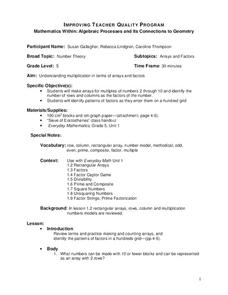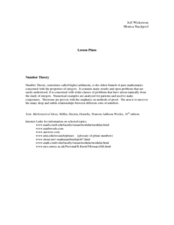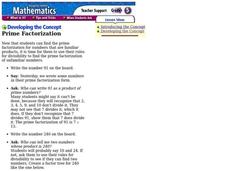Curated OER
Prime and Composite Numbers
Sixth graders inspect prime and composite numbers. Using graph paper, they draw as many different shaped rectangles as possible. They use the dimensions of the rectangles to discuss prime and composite numbers. Students create a chart...
Curated OER
TI-82 PROFICIENCY
Students find the proper factors for numbers one through fifty using either the divisibility laws or TI-82. They determine the sum of the proper factors for each number. If the sum of the factors is less than the number itself, then this...
Curated OER
Prime and Composite Numbers
Fifth graders investigate the concepts of composite and prime numbers. They factor different numbers and determine the number of factors for each. Based upon this information the number is declared prime or composite.
Curated OER
Mathematics Within: Algebraic Processes and Its Connections to Geometry
Fifth graders discover the connections between algebra and geometry. With a focus on arrays and factors, they are introduced to multiplication. They develop an array for multiples of 2 through 10 and identify the factors of each row....
Curated OER
Math: Am I Prime?
Seventh graders determine the difference between prime and composite numbers. On a Website, they discover a method to identify all the prime numbers up to 100 and also complete several online activities. Once they have discussed the...
Curated OER
Perfect Numbers
Sixth graders classify numbers as abundant, deficient, or perfect based on the relationship between the number and its factors. They review factor game using the completed lab sheet. When playing the factor game which type of numbers...
Curated OER
Number Theory
Learners explore the concept of number theory. They discuss an assortment of number theory topics such as prime numbers, composite numbers, GCF, modular arithmetic, and others in a lecture style discussion. Pupils view videos about these...
Curated OER
Prime Factorization
Learners work with prime numbers. In this prime factorization lesson, students review writing numbers in their prime factorization form and solve multiple problems.
EngageNY
Dividing by (x – a) and (x + a)
Patterns in math emerge from seemingly random places. Learners explore the patterns for factoring the sum and differences of perfect roots. Analyzing these patterns helps young mathematicians develop the polynomial identities.
Curated OER
Life in Old Babylonia: The Importance of Trade
Students read maps and artifacts for information indicating the existence of a trade network in Old Babylonia and beyond. They list goods imported to and exported from Babylonia. They indicate trading centers on a map of ancient...
Curated OER
Prime and Composite
Sixth graders practice implementing manipulative's to assess composite and prime numbers. They formulate representations of rational numbers in a variety of ways including graph paper, sieves of Eratosthenes and multiple worksheets.
Curated OER
Quickies
In this math problem solving worksheet, students answer 5 problems in 10 minutes. The problems include a variety of questions that could be solved by students who have had geometry and algebra.
Curated OER
More Equations - Week 8 (Consecutive Numbers)
In this consecutive numbers worksheet, students determine consecutive numbers in a sequence, solve problems using the quadratic equation, and examine coefficients. This two-page worksheet contains eight problems.
Curated OER
Linear Inequalities
Ninth graders practice recognizing similarities and differences found in the graphing of inequalities and equations. Once observatioons are made they solve some of their own applying prior knowledge.
















